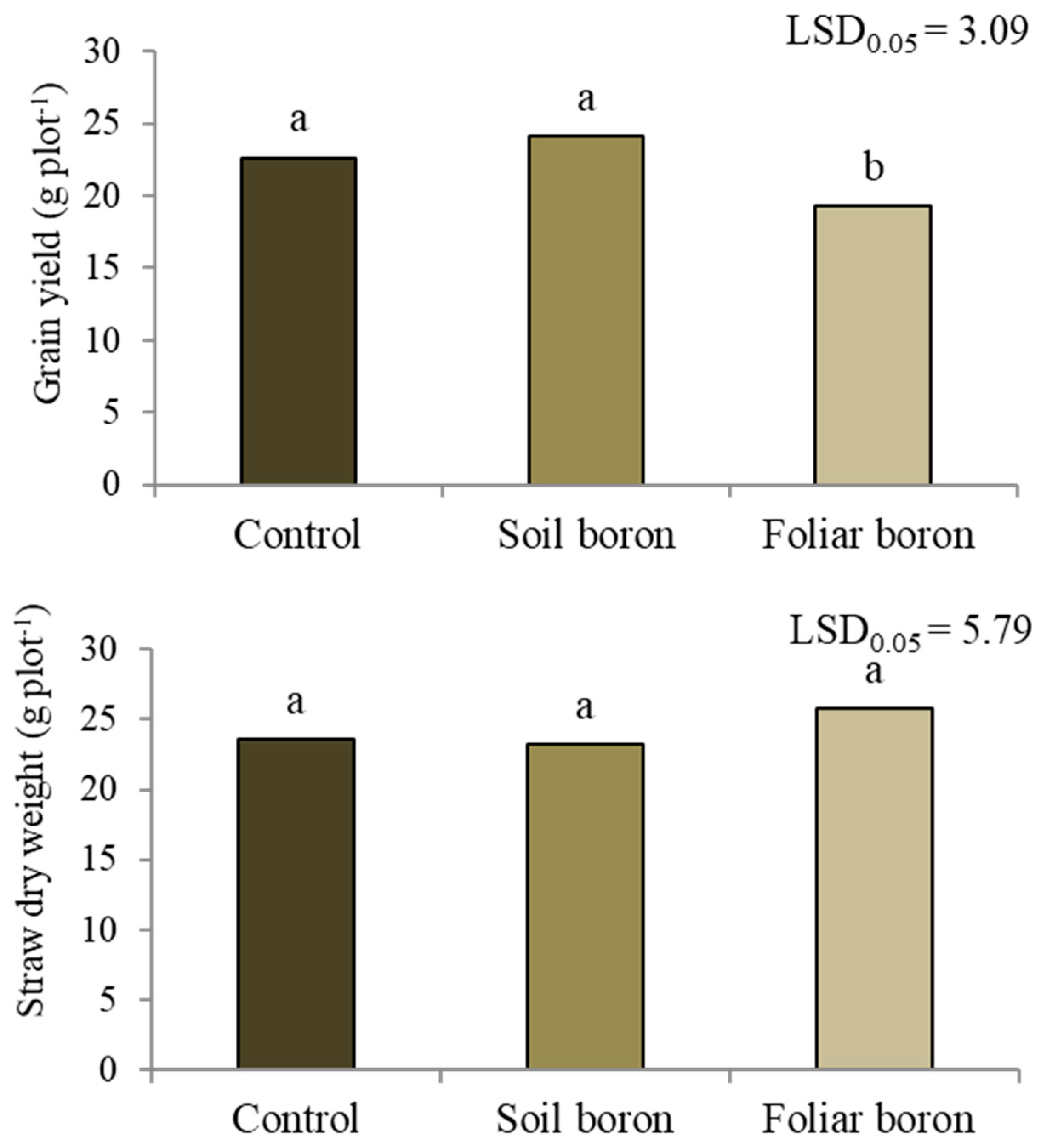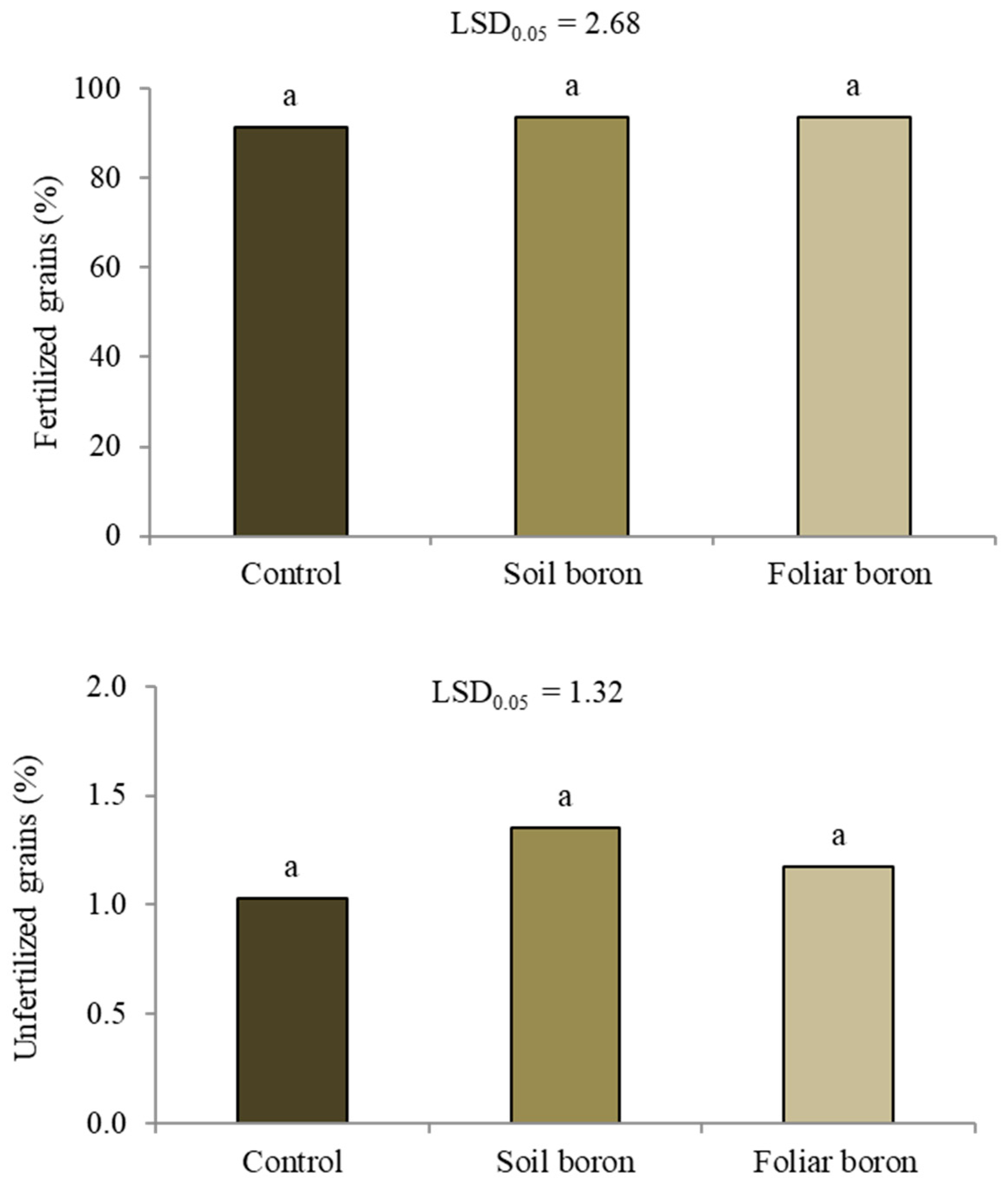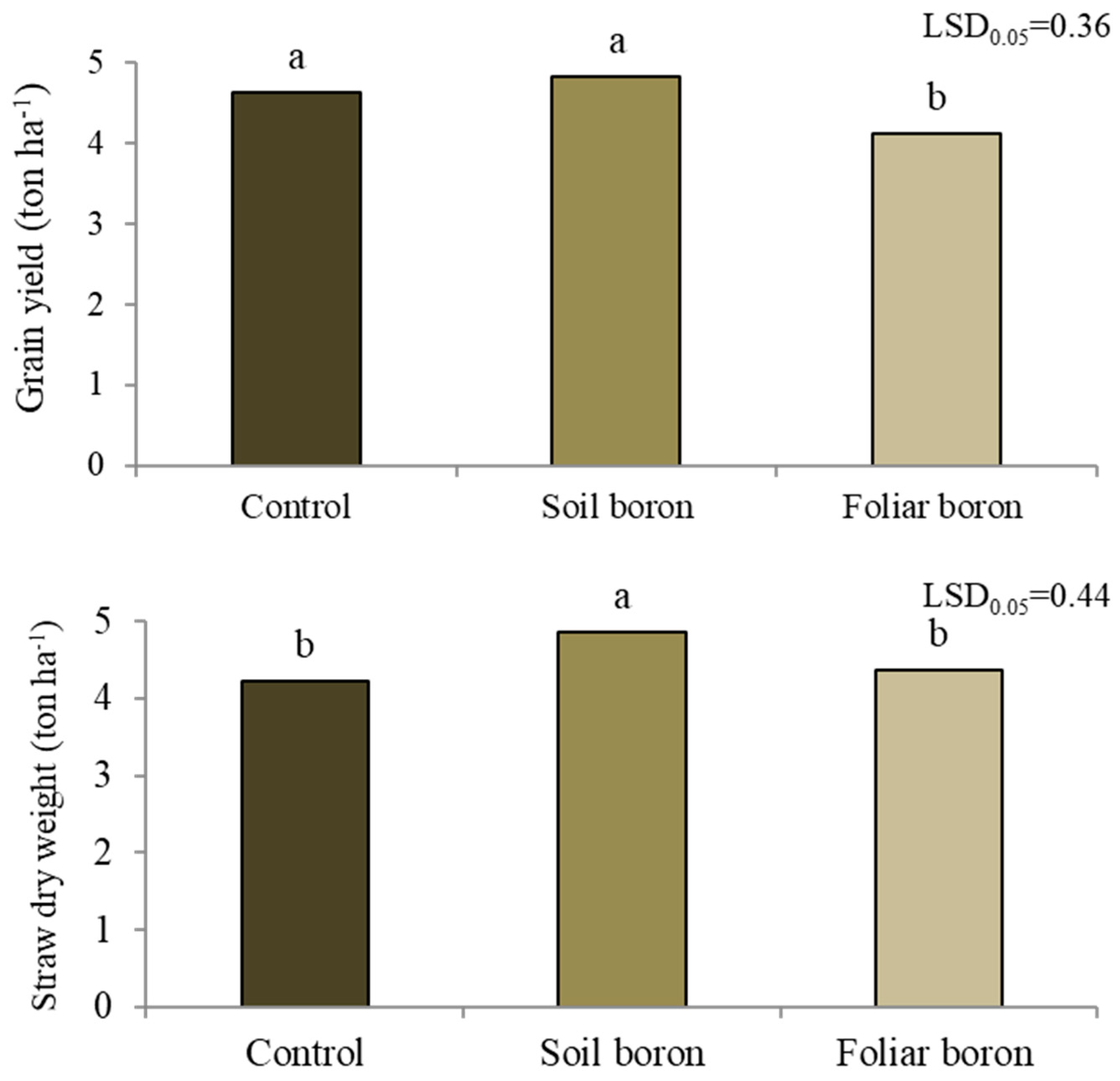Efficacy of Soil and Foliar Boron Fertilizer on Boron Uptake and Productivity in Rice
Abstract
1. Introduction
2. Materials and Methods
2.1. Pot Experiment
2.2. Sample Preparation and Chemical Analysis
2.3. Field Experiment
2.4. Sample Preparation and Chemical Analysis
2.5. Statistical Analysis
3. Results
3.1. Pot Experiment
3.2. Field Experiment
4. Discussion
5. Conclusions
Author Contributions
Funding
Data Availability Statement
Acknowledgments
Conflicts of Interest
References
- Mughal, M.; Fontan Sers, C. Cereal production, undernourishment, and food insecurity in South Asia. Rev. Dev. Econ. 2020, 24, 524–545. [Google Scholar] [CrossRef]
- Yuan, S.; Stuart, A.M.; Laborte , A.G.; Edreira, J.I.R.; Dobermann, A.; Kien, L.V.N.; Thúy, L.T.; Paothong, K.; Traesang, P.; Tint, K.M.; et al. Southeast Asia must narrow down the yield gap to continue to be a major rice bowl. Nat. Food 2022, 3, 217–226. [Google Scholar] [CrossRef]
- Chaiwong, N.; Prom-u-thai, C. Significant roles of silicon for improving crop productivity and factors affecting silicon uptake and accumulation in rice: A Review. J. Soil Sci. Plant Nutr. 2022, 22, 1970–1982. [Google Scholar] [CrossRef]
- Zhichkin, K.A.; Nosov, V.Y.; Zhichkina, L.N.; Ramazanov, I.A.; Kotyazhov, A.V.; Abdulragimov, I.A. The food security concept as the state support basis for agriculture. Agron. Res. 2021, 19, 629–637. [Google Scholar]
- Prom-U-Thai, C.; Rashid, A.; Ram, H.; Zou, C.; Guilherme, L.R.G.; Corguinha, A.P.B.; Guo, S.; Kaur, C.; Naeem, A.; Yamuangmorn, S.; et al. Simultaneous Biofortification of Rice with Zinc, Iodine, Iron and Selenium Through Foliar Treatment of a Micronutrient Cocktail in Five Countries. Front. Plant Sci. 2020, 11, 589835. [Google Scholar] [CrossRef] [PubMed]
- Khampuang, K.; Lordkaew, S.; Dell, B.; Prom-u-thai, C. Foliar zinc application improved grain zinc accumulation and bioavailable zinc in unpolished and polished rice. Plant Prod. Sci. 2021, 24, 94–102. [Google Scholar] [CrossRef]
- Bouis, H.E.; Saltzman, A. Improving nutrition through biofortification: A review of evidence from HarvestPlus, 2003 through 2016. Glob. Food Secur. 2017, 12, 49–58. [Google Scholar] [CrossRef]
- Yang, X.D.; Sun, S.Q.; Li, Y.Q. Boron deficiency causes changes in the distribution of major polysaccharides of the pollen tube wall. Acta Bot. Sin. 1999, 41, 1169–1176. [Google Scholar]
- Lordkaew, S.; Konsaeng, S.; Jongjaidee, J.; Dell, B.; Rerkasem, B.; Jamjod, S. Variation in responses to boron in rice. Plant Soil 2013, 36, 287–295. [Google Scholar] [CrossRef]
- Rehman, A.; Farooq, M.; Nawaz, A.; Ahmad, R. Influence of boron nutrition on rice productivity, kernel quality and biofortification in different production systems. Field Crops Res. 2014, 169, 123–131. [Google Scholar] [CrossRef]
- Shahid, M.; Nayak, A.K.; Tripathi, R.; Katara, J.L.; Bihari, P.; Lal, B.; Gautam, P. Boron application improves yield of rice cultivars under high temperature stress during vegetative and reproductive stages. Int. J. Biometeorol. 2018, 62, 1375–1387. [Google Scholar] [CrossRef] [PubMed]
- Marschner, P. Mineral Nutrition of Higher Plants, 3rd ed.; Academic Press: London, UK, 2012. [Google Scholar]
- Shah, J.A.; Memon, M.Y.; Aslam, M.; Depar, N.; Sial, N.A.; Khan, P. Response of two rice varieties viz., Khushboo-95 and Mehak to different levels of boron. Pak. J. Bot. 2011, 43, 1021–1031. [Google Scholar]
- Rerkasem, B.; Netsangtip, R.; Lordkaew, S.; Cheng, C. Grain set failure in boron deficient wheat. Plant Soil 1993, 155–156, 309–312. [Google Scholar] [CrossRef]
- Shorrocks, V.M. The occurrence and correction of boron deficiency. Plant Soil 1997, 193, 121–148. [Google Scholar] [CrossRef]
- Rashid, A.; Yasin, M.; Ali, M.A.; Ahmad, Z.; Ullah, R. An alarming boron deficiency in calcareous rice soils of Pakistan: Boron use improves yield and cooking quality. In Advances in Plant and Animal Boron Nutrition, Proceedings of the 3rd International Symposium on All Aspects of Plant and Animal Boron Nutrition, Wuhan, China, 9–13 September 2005; Xu, F., Ed.; Springer: Dordrecht, The Netherlands, 2007; pp. 103–116. [Google Scholar]
- Rashid, A.; Muhammad, S.; Rafique, E. Genotypic variation in boron uptake and utilization by rice and wheat. In Boron in Plant and Animal Nutrition; Goldbach, H.E., Rerkasem, B., Wimmer, M.A., Brown, P.H., Thellier, M., Bell, R.W., Eds.; Kluwer Academic: New York, NY, USA, 2002; pp. 305–310. [Google Scholar]
- Chaiwong, N.; Lordkaew, S.; Yimyam, N.; Rerkasem, B.; Prom-u-thai, C. Silicon nutrition and distribution in plants of different Thai rice varieties. Int. J. Agric. Biol. 2018, 20, 669–675. [Google Scholar] [CrossRef]
- Lohse, G. Microanalytical azomethine-H method for boron determination in plant tissue. Commun. Soil Sci. Plant Anal. 1982, 13, 127–134. [Google Scholar] [CrossRef]
- Abdel-Motagally, F.M.F.; El-Zohri, M. Improvement of wheat yield grown under drought stress by boron foliar application at different growth stages. J. Saudi Soc. Agric. Sci. 2016, 17, 178–185. [Google Scholar] [CrossRef]
- Wang, S.; Yoshinari, A.; Shimada, T.; Hara-Nishimura, I.; Mitani-Ueno, N.; Ma, J.F.; Naito, S.; Takano, J. Polar localization of the NIP5; 1 boric acid channel is maintained by endocytosis and facilitates boron transport in Arabidopsis roots. Plant Cell 2017, 29, 824–842. [Google Scholar] [CrossRef]
- Diana, G. Boron in the soil, from deficit to toxicity. Inf. Agrar. 2006, 62, 54–58. [Google Scholar]
- Yamaji, N.; Ma, J.F. Metalloid transporters and their regulation in plants. Plant Physiol. 2021, 187, 1929–1939. [Google Scholar] [CrossRef]
- Rehman, A.; Farooq, M.; Rashid, A.; Nadeem, F.; Stuerz, S.; Asch, F.; Bell, R.W.; Siddique, K.H.M. Boron nutrition of rice in different production systems. A review. Agron. Sustain. Dev. 2018, 38, 25. [Google Scholar] [CrossRef]
- Wu, X.W.; Lu, X.P.; Riaz, M.; Yan, L.; Jiang, C.C. Boron toxicity induced different changes of the cell ultrastructure and architecture of components in different leaf segments of trifoliate orange. J. Environ. Manag. 2019, 246, 426–433. [Google Scholar] [CrossRef] [PubMed]
- Torun, B.; Kalayci, M.; Ozturk, L.; Ayfer, A.T. Differences in Shoot Boron Concentrations, Leaf Symptoms, and Yield of Turkish Barley Cultivars Grown on Boron-Toxic Soil in Field. J. Plant Nutr. 2007, 26, 1735–1747. [Google Scholar] [CrossRef]
- Choi, E.Y.; McNeill, A.M.; Coventry, D.; Stangoulis, J.C.R. Whole plant response of crop and weed species to high subsoil boron. Aust. J. Agric. Res. 2006, 57, 761–770. [Google Scholar] [CrossRef]
- Reid, R.J.; Fitzpatrick, K.L. Redistribution of boron in leaves reduces boron toxicity. Plant Signal. Behav. 2009, 4, 1091–1093. [Google Scholar] [CrossRef]
- Onuh, A.F.; Miwa, K. Regulation, diversity and evolution of boron transporters in plants. Plant Cell Physiol. 2021, 62, 590–599. [Google Scholar] [CrossRef]
- Nable, R.O.; Banuelos, G.S.; Paull, J.G. Boron toxicity. Plant Soil 1997, 193, 181–198. [Google Scholar] [CrossRef]
- Ma, J.F.; Tamai, K.; Yamaji, N.; Mitani, N.; Konishi, S.; Katsuhara, M.; Ishiguro, M.; Murata, Y.; Yano, M. A silicon transporter in rice. Nature 2006, 440, 688–691. [Google Scholar] [CrossRef]
- Mitani, N.; Yamaji, N.; Ma, J.F. Characterization of substrate specificity of a rice silicon transporter, Lsi1. Pflügers Arch.-Eur. J. Physiol. 2008, 456, 679–686. [Google Scholar] [CrossRef]
- Schnurbusch, T.; Hayes, J.; Hrmova, M.; Baumann, U.; Ramesh, S.A.; Tyerman, S.D.; Langridge, P.; Sutton, T. Boron toxicity tolerance in barley through reduced expression of the multifunctional aquaporin HvNIP2;1. Plant Physiol. 2010, 153, 1706–1715. [Google Scholar] [CrossRef]
- Shao, J.F.; Yamaji, N.; Liu, X.W.; Yokosho, K.; Shen, R.F.; Ma, J.F. Preferential distribution of boron to developing tissues is mediated by the intrinsic protein OsNIP3. Plant Physiol. 2018, 176, 1739–1750. [Google Scholar] [CrossRef] [PubMed]
- Nakagawa, Y.; Hanaoka, H.; Kobayashi, M.; Miyoshi, K.; Miwa, K.; Fujiwara, T. Cell-type specificity of the expression of OsBOR1, a rice efflux boron transporter gene, is regulated in response to boron availability for efficient boron uptake and xylem loading. Plant Cell 2007, 19, 2624–2635. [Google Scholar] [CrossRef] [PubMed]
- Uraguchi, S.; Fujiwara, T. Significant contribution of boron stored in seeds to initial growth of rice seedlings. Plant Soil 2011, 340, 435–442. [Google Scholar] [CrossRef]
- Rerkasem, B.; Jamjod, S. Boron deficiency in wheat: A review. Field Crops Res. 2004, 89, 173–186. [Google Scholar] [CrossRef]
- Dell, B.; Huang, L. Physiological response of plants to low boron. Plant Soil 1997, 193, 103–120. [Google Scholar] [CrossRef]
- Wang, Q.; Lu, L.; Wu, X.; Li, Y.; Lin, J. Boron influences pollen germination and pollen tube growth in Picea meyeri. Tree Physiol. 2003, 23, 345–351. [Google Scholar] [CrossRef]



| Treatment | No. of Tillers Plant−1 | No. of Panicles Plant−1 | Filled Grain (%) | 1000 Seed Weight (g) | Harvest Index |
|---|---|---|---|---|---|
| Control | 4.3 | 4.0 a | 89.4 | 33.4 | 0.42 ab |
| Soil boron | 3.3 | 3.7 a | 89.1 | 32.6 | 0.44 a |
| Foliar boron | 4.0 | 3.0 b | 90.9 | 31.7 | 0.40 b |
| Mean | 3.7 | 3.6 | 89.8 | 32.5 | 0.42 |
| F-test | ns | * | ns | ns | * |
| LSD0.05 | 1.49 | 0.67 | 6.15 | 1.46 | 0.03 |
| CV (%) | 12.86 | 9.38 | 3.43 | 2.24 | 5.10 |
| Treatment | B Concentration (mg kg−1) | B Uptake (mg pot−1) | |||
|---|---|---|---|---|---|
| Stem | Leaf | Flag Leaf | Grain | ||
| Control | 2.9 b | 14.6 b | 14.2 b | 14.8 | 1.5 b |
| Soil boron | 1.5 c | 39.4 a | 50.7 a | 13.1 | 2.5 a |
| Foliar boron | 4.7 a | 3.3 c | 26.1 b | 15.4 | 1.7 b |
| Mean | 3.0 | 19.1 | 30.3 | 14.4 | 1.9 |
| F-test | ** | *** | ** | ns | ** |
| LSD0.05 | 0.95 | 3.54 | 14.82 | 3.37 | 0.36 |
| CV (%) | 15.8 | 9.29 | 24.45 | 11.68 | 9.75 |
| Treatment | Tiller Nos. Plant−1 | Panicle Nos. Plant−1 | Filled Grain (%) | 1000 Seed Weight (g) | Harvest Index |
|---|---|---|---|---|---|
| Control | 14.3 b | 13.6 b | 78.3 b | 30.4 | 0.48 a |
| Soil boron | 14.3 b | 13.8 b | 82.5 a | 30.8 | 0.46 ab |
| Foliar boron | 16.2 a | 15.7 a | 82.3 a | 30.7 | 0.45 b |
| Mean | 14.9 | 14.4 | 81.1 | 30.6 | 0.46 |
| F-test | ** | ** | * | ns | * |
| LSD0.05 | 0.95 | 0.77 | 3.58 | 0.75 | 0.03 |
| CV (%) | 3.68 | 3.11 | 2.55 | 1.42 | 4.45 |
| Treatment | B Concentration (mg kg−1) | B Uptake | ||
|---|---|---|---|---|
| Stem | Leaf | Flag Leaf | (mg m−2) | |
| Control | 3.1 b | 7.5 b | 8.9 c | 3.6 ab |
| Soil boron | 3.9 a | 14.1 a | 15.5 a | 4.7 a |
| Foliar boron | 3.5 ab | 8.1 b | 12.5 b | 3.3 b |
| Mean | 3.5 | 9.9 | 12.3 | 3.9 |
| F-test | * | ** | ** | * |
| LSD0.05 | 0.62 | 2 | 1.61 | 1.08 |
| CV (%) | 10.38 | 11.64 | 7.61 | 16.25 |
Disclaimer/Publisher’s Note: The statements, opinions and data contained in all publications are solely those of the individual author(s) and contributor(s) and not of MDPI and/or the editor(s). MDPI and/or the editor(s) disclaim responsibility for any injury to people or property resulting from any ideas, methods, instructions or products referred to in the content. |
© 2023 by the authors. Licensee MDPI, Basel, Switzerland. This article is an open access article distributed under the terms and conditions of the Creative Commons Attribution (CC BY) license (https://creativecommons.org/licenses/by/4.0/).
Share and Cite
Songsriin, J.; Yamuangmorn, S.; Lordkaew, S.; Jumrus, S.; Veeradittakit, J.; Jamjod, S.; Prom-u-thai, C. Efficacy of Soil and Foliar Boron Fertilizer on Boron Uptake and Productivity in Rice. Agronomy 2023, 13, 692. https://doi.org/10.3390/agronomy13030692
Songsriin J, Yamuangmorn S, Lordkaew S, Jumrus S, Veeradittakit J, Jamjod S, Prom-u-thai C. Efficacy of Soil and Foliar Boron Fertilizer on Boron Uptake and Productivity in Rice. Agronomy. 2023; 13(3):692. https://doi.org/10.3390/agronomy13030692
Chicago/Turabian StyleSongsriin, Jintana, Supapohn Yamuangmorn, Sithisavet Lordkaew, Suchada Jumrus, Jeeraporn Veeradittakit, Sansanee Jamjod, and Chanakan Prom-u-thai. 2023. "Efficacy of Soil and Foliar Boron Fertilizer on Boron Uptake and Productivity in Rice" Agronomy 13, no. 3: 692. https://doi.org/10.3390/agronomy13030692
APA StyleSongsriin, J., Yamuangmorn, S., Lordkaew, S., Jumrus, S., Veeradittakit, J., Jamjod, S., & Prom-u-thai, C. (2023). Efficacy of Soil and Foliar Boron Fertilizer on Boron Uptake and Productivity in Rice. Agronomy, 13(3), 692. https://doi.org/10.3390/agronomy13030692






